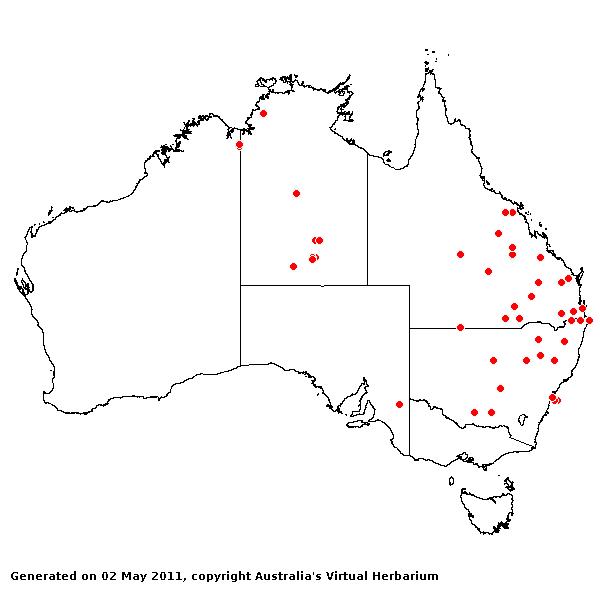Panicum
antidotale* Retz. Obs.
Bot. 4: 17 (1786). Classification. (GPWG 2001) : Subfamily
Panicoideae. Paniceae.
Type of Basionym or
Protologue Information: HT: Koenig s.n., India (LD; IT: K, US).
Key references
(books and floras): [1878] G.Bentham, Flora Australiensis 7 (483),
[1952] C.A.Gardner, Flora of Western Australia 1 Gramineae (258),
[2002] D.Sharp & B.K.Simon, AusGrass, Grasses of Australia, [2006]
J.Jessop, G.R.M.Dashorst, F.M.James, Grasses of South Australia (457),
[2008] S.W.L.Jacobs, R.D.B.Walley & D.J.B.Wheeler, Grasses of New South
Wales.
Illustrations:
[2006] J.Jessop, G.R.M.Dashorst, F.M.James, Grasses of South Australia (457, fig. 388), [2008] S.W.L.Jacobs,
R.D.B.Whalley & D.J.B.Wheeler, Grasses of New South Wales, 4th edn
(314).
Habit.
Perennial. Rhizomes present, short. Stolons absent. Culms erect or geniculately
ascending, 30–200 cm tall, woody, 5–15 -noded. Mid-culm internodes pruinose or
glabrous. Mid-culm nodes glabrous or pubescent. Lateral branches sparsely
branched or branched. Leaf-sheath auricles absent. Ligule a fringed membrane or
a fringe of hairs. Leaf-blades 6–30 cm long, 2.5–15 mm wide. Leaf-blade surface
smooth.
Inflorescence.
Inflorescence compound, a panicle. Panicle oblong or ovate or pyramidal, 13–32
cm long, contracted about primary branches.
Spikelets.
Spikelets pedicelled. Fertile spikelets 2-flowered, the lower floret barren
(rarely male), the upper fertile, comprising 1 basal sterile florets,
comprising 1 fertile floret(s), without rachilla extension, elliptic or ovate,
dorsally compressed, 2.4–3.2 mm long. Rhachilla internodes brief up to lowest
fertile floret.
Glumes. Glumes
thinner than fertile lemma. Lower glume ovate, membranous, much thinner on
margins, without keels, 3–5 -nerved. Lower glume apex muticous. Upper glume
ovate, 2.5–3.2 mm long, membranous, without keels, 7–9 -nerved. Florets.
Basal sterile florets 1, male or barren, with palea. Lemma of lower sterile
floret 100 % of length of spikelet, membranous, 7–9 -nerved, mucronate.
Fertile lemma 1.5–2.6
mm long, without keel. Lemma apex muticous or mucronate. Anthers 3. Grain 0.25
mm long.
Continental
Distribution: Africa, Temperate Asia, Tropical Asia, Australasia, Pacific,
North America, and South America.
Australian
Distribution: Western Australia, Northern Territory, South Australia,
Queensland, New South Wales.
Western Australia:
Gardner. Drummond. Northern Territory: Darwin & Gulf, Central
Australia North, Central Australia South. Queensland: Burnett, Darling
Downs, Leichhardt, Maranoa, Mitchell, Port Curtis, South Kennedy, Warrego,
Moreton. New South Wales: Northern Tablelands, North-Western Slopes,
North-Western Plains.
Notes.
Similar to P. coloratum. Diagnostic features include pronounced rhizomes
with hairy cataphylls, the male lower floret, and the glume more than 1/3 the
length of the spikelet.
Introduced. Native to
India but now widely introduced as a forage species or for soil binding. In
Brigalow forests, tropical and subtropical sub-humid woodlands, temperate
sub-humid woodlands, semi-arid shrub woodlands, acacia shrublands, and arid
hummock grasslands. Flowers essentially throughout the year.




